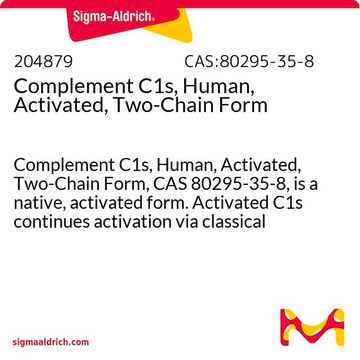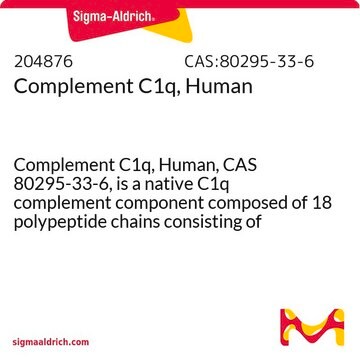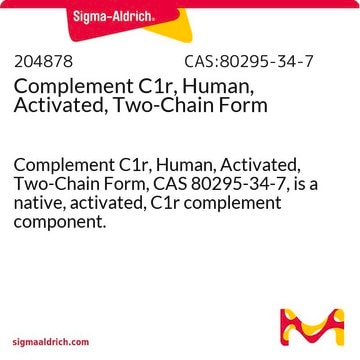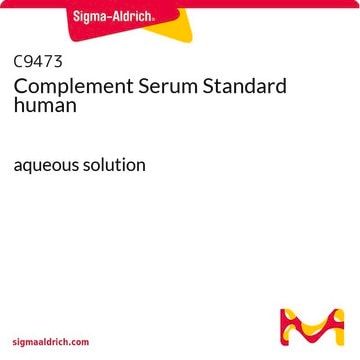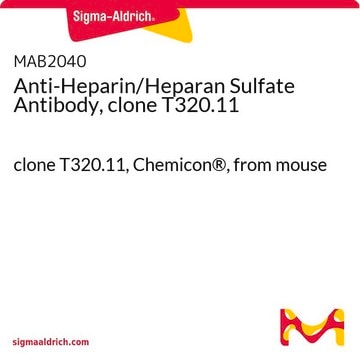204873
Complement C1, Human
Complement C1, Human Native, is the first component of the classical complement pathway. It is a calcium-dependent complex of C1q, C1r, and C1s subcomponents.
Se connecterpour consulter vos tarifs contractuels et ceux de votre entreprise/organisme
About This Item
Code UNSPSC :
12352202
Nomenclature NACRES :
NA.25
Produits recommandés
Niveau de qualité
Forme
liquid
Fabricant/nom de marque
Calbiochem®
Conditions de stockage
OK to freeze
avoid repeated freeze/thaw cycles
Conditions d'expédition
wet ice
Température de stockage
−70°C
Description générale
Native, human C1 complement component. C1 is the first component of the classical complement pathway. It is a calcium dependent complex of C1q, C1r, and C1s subcomponents which are present in the C1 complex at molar ratios of 1:2:2 respectively. Binding of C1 to classical pathway activators results in the conversion of the proenzyme C1s subcomponent to an active C1s enzyme. C1s enzyme cleaves both C4 and C2, resulting in formation of the C3 cleaving enzyme, C4b, C2a, of the classical complement pathway. C1 concentration is based on functional activity measurements relative to a normal serum standard pool.
Native, human C1 complement component. C1 is the first component of the classical complement pathway. It is a calcium-dependent complex of C1q, C1r, and C1s subcomponents which are present in the C1 complex at molar ratios of 1:2:2, respectively. Binding of C1 to classical pathway activators results in the conversion of the proenzyme C1s subcomponent to an active C1s enzyme. C1s enzyme cleaves both C4 and C2 resulting in formation of the C3 cleaving enzyme, C4b, C2a, of the classical complement pathway. C1 concentration is based on functional activity measurements relative to a normal serum standard pool.
Conditionnement
Please refer to vial label for lot-specific concentration.
Avertissement
Toxicity: Standard Handling (A)
Forme physique
In 300 mM NaCl, 50 mM sodium acetate, 50 mM EACA, 25 µM NPGB, 10 mM benzamidine, 10 mM EDTA, 40% glycerol, pH 5.5.
Autres remarques
Cooper, N.R. 1985. Adv. Immunol. 37, 151.
Ziccardi, R.J. and Cooper, N.R. 1977. J. Immunol. 118, 2047.
Ziccardi, R.J. and Cooper, N.R. 1977. J. Immunol. 118, 2047.
Informations légales
CALBIOCHEM is a registered trademark of Merck KGaA, Darmstadt, Germany
Code de la classe de stockage
10 - Combustible liquids
Classe de danger pour l'eau (WGK)
WGK 1
Point d'éclair (°F)
Not applicable
Point d'éclair (°C)
Not applicable
Certificats d'analyse (COA)
Recherchez un Certificats d'analyse (COA) en saisissant le numéro de lot du produit. Les numéros de lot figurent sur l'étiquette du produit après les mots "Lot" ou "Batch".
Déjà en possession de ce produit ?
Retrouvez la documentation relative aux produits que vous avez récemment achetés dans la Bibliothèque de documents.
Yitian Cai et al.
Journal of immunology (Baltimore, Md. : 1950), 199(12), 3981-3990 (2017-10-27)
Anti-nuclear autoantibodies, which frequently target the nucleoli, are pathogenic hallmarks of systemic lupus erythematosus (SLE). Although the causes of these Abs remain broad and ill-defined, a genetic deficiency in C1 complex (C1qC1r2C1s2) or C4 is able to induce these Abs.
Yitian Cai et al.
The Journal of biological chemistry, 290(37), 22570-22580 (2015-08-02)
In infection, complement C1q recognizes pathogen-congregated antibodies and elicits complement activation. Among endogenous ligands, C1q binds to DNA and apoptotic cells, but whether C1q binds to nuclear DNA in apoptotic cells remains to be investigated. With UV irradiation-induced apoptosis, C1q
Réka Á Kovács et al.
Frontiers in immunology, 11, 599771-599771 (2021-02-26)
Elements of the immune system particularly that of innate immunity, play important roles beyond their traditional tasks in host defense, including manifold roles in the nervous system. Complement-mediated synaptic pruning is essential in the developing and healthy functioning brain and
Ahsan Habib et al.
Cell transplantation, 27(4), 666-676 (2018-06-07)
Alzheimer's Disease (AD) is the leading cause of dementia in the elderly. In healthy individuals, amyloid precursor protein (APP) is cleaved by α-secretase, generating soluble α-amyloid precursor protein (sAPPα), which contributes neuroprotective functions in the neuronal environment. In contrast, in
Notre équipe de scientifiques dispose d'une expérience dans tous les secteurs de la recherche, notamment en sciences de la vie, science des matériaux, synthèse chimique, chromatographie, analyse et dans de nombreux autres domaines..
Contacter notre Service technique
